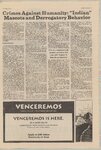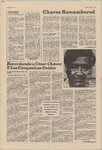| OCR Text |
Show VENCEREMOS . a SPRING 2000 CTIVISM: 0no Y SLICA Se: ECAO $ HUMANO Mexican Students Strike To Protect Free Education SOAR, joined forces with a by Karla Motta On April 19, 1999 thousands of students from one of Latin Americas largest universities, the National Autonomous University of Mexico (UNAM) went on strike. The cause of this conflict was a vicious attack, sponsored by the the International Monetary Fund, or IMF, and launched by President Ernesto Zedillo, against public education. The IMF is an institution which keeps a strong-hold on developing and third world countries. They control their economies through global loan-sharking. For example, most countries take loans from the IMF in order to pay off any debts they may Why a strike? On the eleventh of February last year Francisco Barnes de Castro, chief administrator of the largest institution of higher education “in Mexico, announced that starting August of 1999 tuition fees ranging from US$60 to US$80 [$540 to $720 pesos] would be imposed on all students, except those from low-income families. Although the proposed fees might not seem like a large increase to students in the United States, it is to the low income students in Mexico. One of the main reasons students decided to try and put up a fight to this agonizing situation was because for years UNAM has been relatively tuition free. LA JORNA and entity. This institution has demanded that the Mexican government eliminates their free tuition policy. Otherwise they have threatened to eliminate any World Bank assistance. It didn't seem fair to students who cannot afford to pay that amount of money. Not only is it not fair, it is violating a section in the Mexican constitution which clearly states that the education in Mexico will be “free, and GO Firma, group of carpenters and community groups to protes the Us treatment of workers. We walked through campus chanting and hoping that our message would somehow send a wave of enthusiasm through the countless ranks of people who feel left out of the economic prosperity in which so many try to convince us “we are participating. A brotherly love developed on that: afternoon between out-of-work carpenters, environmentalists, and progressives of all types. That is the essence of student activism, that is its beauty. Imagine, if for only a second, what the students at one of the largest universities in the world are feeling while they enter their 10th month of a student strike. : The tensions and angst must be surreal. The anxiety must be at a pinnacle, and their lives must be in another dimension. They have set an example to people all over the world. Their message, that people deserve an education of the highest quality no matter what their economic or social situation, is resonating in our ears. If only students in the United States realized the power they hold and the changes that could be made if they only took the future of public education into their hands and demanded that our leaders create a system that is not only fair but inclusive to everyone. have. In creating a contract to pay off these debts, they also sign contracts that give the IMF lobbying power or influence in almost every nationalized OF JOSE Editor's Note: On November 10, 1999 students at the University of Utah felt for the first time in many years what it was like to participate in true student activism. About 100 students from the Student Labor Action Committee, MECHA, Terra forbids the institution from charging fees and tuition.” It was one of the accomplishments of the Mexican Revolution of 1910. Previous Strikes “Zapata fought so we could study......” chanted the anti-fees demonstration crowd on February 26. Little did they know what was to come in the following months. In March and early April, weekly crowds of approximately 80,000 students formed, as well as scheduled meetings. In the months to come, the activists had adot of support on their side, including members of the General Strike council or CGH, the University Non-Academic Workers Union STUNAM, and last but not least, Subcomandante Marcos, leader of the Zapatistas in Chiapas who issued close to daily attacks against Barnes' actions. In late May students were faced with a dilemma. Barnes made a brilliant anti-strike and anti-student maneuver. He tried to convince students that the COURTESY Ll lA AA .8 STANDING STRONG: Manifestantes in Mexico City reaffirmed their commitment e the student strike at this rally in late January. fees would be voluntary in hopes that the strike would end. If it did end peacefully, he agreed that no disciplinary actions would be brought against the striking students. The idea was perfect for Barnes, because if the students agreed, it would have been their loss one way or another. Once they had settled an agreement the administration in the future could change the voluntary policy to mandatory. The students did not accept Barnes” offer, and are continuing to strike. Update In early November, the sun shone on students as news of Francisco Barnes de Castro's resignation hit the stands. Barnes had been the number one enemy of the students and the people. to join visit 318 Union or call 581-8151 In the week following Castro's resignation, he was replaced by former Secretary of Health de las Fuentes. To date, little is known of what de las Fuentes” plans are. The people hope this rector will be able to understand the dilemma that they are facing. It has been seven months since the strike started, and there is still no sign of when the turmoil will end. On November 18, the CGH finally resolved to set a date to begin public dialogue. The only choice that the students are left with is to keep on fighting for their rights. : We can only hope the best for these students, whose only wish is to succeed. As one student leader chanted, quoting Che Guevara, “Hasta la Victoria Siempre!” |


















